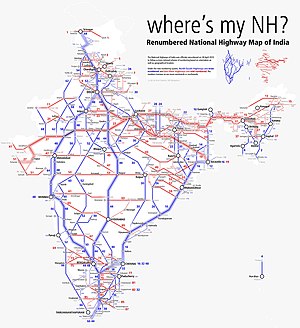
The national highways in India are a network of limited access roads owned by the Ministry of Road Transport and Highways. National highways have flyover access or some controlled-access, where entrance and exit is through the side of the flyover. At each highway intersection, flyovers are provided to bypass the traffic on the city, town, or village. These highways are designed for speeds of 100 km/h. Some national highways have interchanges in between, but do not have total controlled-access throughout the highways. The highways are constructed and managed by the Central Public Works Department (CPWD), the National Highways and Infrastructure Development Corporation Limited (NHIDCL), and the public works departments (PWD) of state governments. Currently, the longest national highway in India is National Highway 44 at 4,112 km (2,555 mi). India started four laning of major national highways with the National Highway Development Project (NHDP). As of March 2022 India has approximately 35,000 km of four laned National highways.
The National Highways Authority of India (NHAI) and the National Highways and Infrastructure Development Corporation Limited (NHIDCL) are the nodal agencies responsible for building, upgrading, and maintaining most of the National Highways network. It operates under the Ministry of Road Transport and Highways. The National Highways Development Project (NHDP) is a major effort to expand and upgrade the network of highways. NHAI often uses a public–private partnership model for highway maintenance, and toll-collection. NHIDCL uses Engineering Procurement and Construction (EPC) model to build, develop and maintain strategic roads in international borders of the country.
In India, National Highways are at-grade roads, whereas Expressways are controlled-access highways where entrance and exit is controlled by the use ramps that are incorporated into the design of the expressway. National Highways follows standards set by Indian Roads Congress and Bureau of Indian Standards.
